An eclectic guest list spanning expertise, disciplines and nationalities assembled in Beijing last weekend for what proved to be a stimulating commune of discussion and brainstorming around immersive media. Sheltered from the icy drizzle and cloying Beijing smog, experts and delegates from China and abroad reviewed the current status of the technology, how it might progress in future and the wider implications of those developments.
Host and curator Kevin Geiger was in his element, whilst Nikk Mitchell made for a charismatic co-host, translator and moderator. Credit and thanks to the Beijing Film Academy’s International Animation & Virtual Reality Research Center for bringing it together. Here are ten of our key takeaways from a fascinating, idea-packed forum.
上周末,来自于各个专业领域、各个学科、各个国家的嘉宾齐聚北京,事实证明,此 次活动激发了人们对于沉浸式媒体的热议和头脑风暴。北京的天气寒冷又下着毛毛细雨,雾霾令人厌烦,在这样的天气下,海内外专家和代表们审视了虚拟现实技术 的当前状态,它的未来又将如何前行,以及技术发展有哪些更广阔的应用。
主持兼策划Kevin Geiger充分施展了其才能,Nikk Mitchell是他的搭档主持,同时也担任翻译和小组主持人。本次活动得益于北京电影学院国际动画与虚拟现实研究中心的组织。下面请和我们一起看看,从这次充满魅力,想法无限的论坛中,我们能学到什么:
The opening of the “Future Trends In Stereoscopic Filmmaking & Virtual Reality” forum in Beijing on December 12th, 2015. Image courtesy of the iAVRrc
VR Evangelists, Prophets & Pioneers 虚拟现实传道者、先知和先锋. Image courtesy of the iAVRrc
1. The ‘How?’ Is Less Important Than The ‘Why?’
‘怎么做’没有‘为什么?’重要
The overriding question about virtual reality is not ‘how do we make it?’ but ‘why should we?’ How can it improve current media? What problems can it solve? How can it better society? Can it advance the human race? Instead of starting by considering existing media and models and how we develop them, we need to project our thinking ahead to where we want to be and the problems we want to solve. Only then should we work backwards, asking ‘how do we get there?’
围绕虚拟现实的首要问题并不是‘怎么去做虚拟现 实’,而是‘为什么我们要做虚拟现实?’虚拟现实如何能提升现有媒体?它能解决哪些问题?它如何能让社会更加美好?它能促进人类发展吗?先不要去考虑现有 的媒体和模式的发展,我们需要前瞻性思考,我们要实现什么,我们想解决哪些问题。之后我们再回过头来,思考‘我们怎么去实现?’
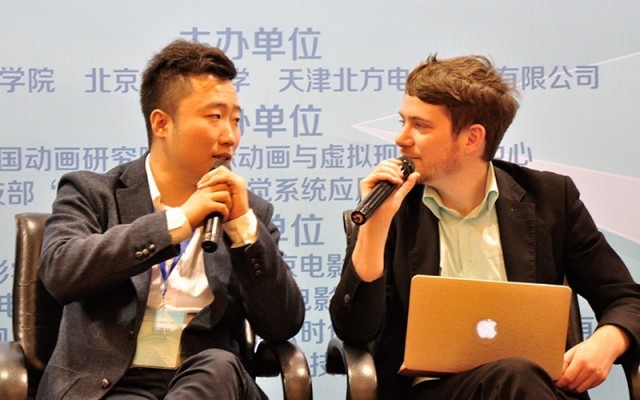 Caixin Media director Qiu Jiaqiu and Forum co-host Nikk Mitchell, Co-Founder & CEO of VR-China.com
Caixin Media director Qiu Jiaqiu and Forum co-host Nikk Mitchell, Co-Founder & CEO of VR-China.com
2. A Lack Of Content
内容的匮乏
Representatives from two major hardware players – Ling VR and HTC Vive – introduced their new products at the Forum. But, for all the buzz around the hardware, there is not enough quality content being developed to start engaging people. Web artist Andy Deck believes getting free, basic development software into the hands of the masses could spark a widespread wave of engagement and creativity, as happened with the internet with software like Mosaic Netscape. Mike Woods (Founder, Framestore’s Digital Department & VR Studio) expressed the need for more top directing, animation and filmmaking talent to make the jump into VR. Former Disney animator, Nik Ranieri, has done just this, evolving throughout his career from 2D hand-drawn animation, to 3D and now VR games.
灵镜VR和HTC Vive两家主要的硬件公司的代表在论坛上介绍了他们的新产品。尽管硬件方面声势浩大,但是没有开发足够多的优质内容,让人们投身其中。网络艺术家 Andy Deck认为,让广大用户免费获取基础开发软件可以触发广泛的参与度和创意,正如当初Mosaic Netscape等软件促进了互联网的发展一样。Mike Woods(Framestore数字部门与虚拟现实工作室的创始人)表示,需要有更多导演,更多动画和电影制作领域的顶级人才投身参与到虚拟现实中来。 前迪士尼动画师Nik Ranieri就是践行者,在他职业生涯中,他从2D手绘动画到3D,现在又投身到虚拟现实游戏中。
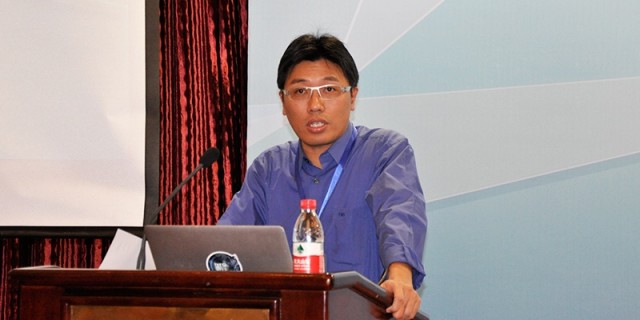 Raymond Pao, Vice President of New Technology, HTC
Raymond Pao, Vice President of New Technology, HTC
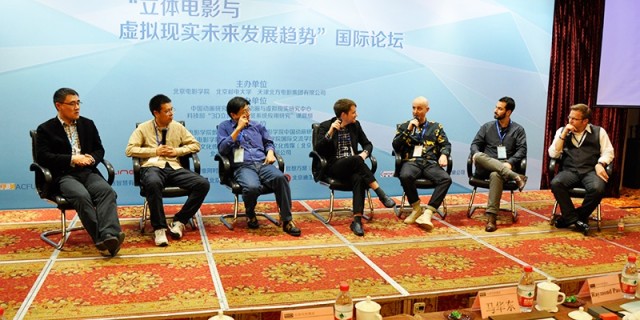
Panelists (L to R): Jerry Ge, Research Vice-President, Analysys – Tim Zhang, Founder & CEO, Ling VR – Raymond Pao, Vice President of New Technology, HTC – Nikk Mitchell, moderator – Mike Woods, Founder & CCO, White Rabbit Ventures – Gabriel Diaz, Assistant Professor, Rochester Institute of Technology – Kevin Geiger, Executive Director, International Animation & Virtual Reality Research Center, Beijing Film Academy
3. Games Have An Image Problem
游戏存在形象问题
Games are the most evolved media using VR tech and have the potential to lead the evolution of immersive media. However, the general, non-game playing public still largely believes games to be crass and puerile. If more people tried playing, it would surely demonstrate the fascinating experiences games offer. With all the talk of game tech, but no engagement with the game layman, there’s a danger of pigeonholing VR as merely a ‘game gimmick’. VR games might be well advised follow the example of Nintendo Wii, ‘the game console that non-gamers played’. Through extensive, smart and pushy marketing, Nintendo put the console into the hands of everyday people.
游戏作为虚拟现实技术应用最先进的媒介,有着引领沉浸式媒体 发展的潜力。但是,那些不玩游戏的普通大众大多仍旧认为游戏非常愚蠢幼稚。但是,如果更多的人尝试玩游戏,无疑就会体验到游戏的魅力。如果只是一味的讨论 游戏技术,没有游戏外行参与的话,那么虚拟现实很容易被归类为‘游戏小把戏’。可能就有人建议虚拟现实游戏可以追随任天堂wii游戏机的套路 — ‘不玩游戏的人玩的单机游戏’。任天堂通过广阔、智能又有冲劲的市场,将单机游戏带到了人们的日常生活中。
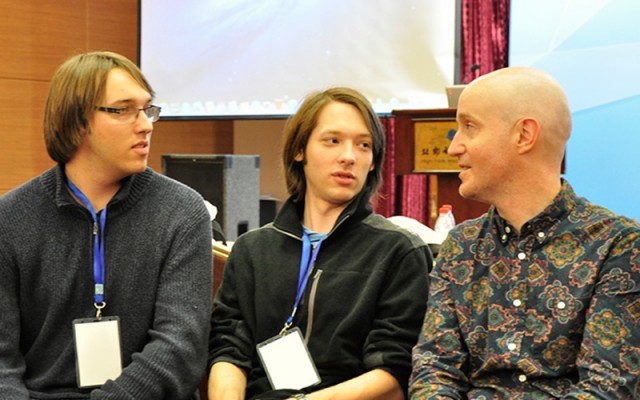
Tyler and Shane Nilsson, Co-founders & Directors, Coal Car Studio and Mike Woods, Founder & CCO, White Rabbit Ventures
4. Engaging The Masses
大众参与
How do we get to a stage where everyday, non-technical people, find AR and VR both usable and useful? Is Google Cardboard good for VR? Geiger suggested that, while primitive, it’s a good ‘gateway drug’ to VR for the masses. But Percy Fung (Digital Magic) suggests there is a danger that people try it once, then put it down never to try again, believing they have ‘done VR’.
我们如何能让日常生活中不懂技术的人也看到,增强现实和虚拟现实对他们来说既可用又有用 呢?谷歌Cardboard有益于虚拟现实的传播吗?Geiger表示,谷歌的这款产品虽然简单,但却是一种可以让大众对虚拟现实“上瘾的毒品”。但是 Percy Fung (麦捷克数字科技有限公司)却认为,也有可能人们尝试用了一下这个产品,就再也不去碰它了,觉得自己就算已经“用过虚拟现实了”。
We have come to think of seeing our experiences in 2D on screens and photographs. As the technology becomes available, we will gradually start to think in 3D to reflect how we actually live our lives. For example, Magic Dumpling’s Yan Yi envisions virtual family video, in which we capture and can look back at various stages of our children’s growth.
我们已经开始体验了2D屏幕和照片。随着技术的发展,我们逐渐开始思考3D,映射出我们实际是怎么生活的。比如,魔力饺子公司的Yan Yi对虚拟家庭视频做出了展望,借此可以捕捉并回顾孩子成长的各个阶段。
Percy Fung, Founder & Director, Digital Magic. Image courtesy of the iAVRrc
5. Learning From The Internet
借鉴互联网
The current VR buzz is reminiscent of the original hype surrounding the internet. In reality, it took years before the web reached anything like maturity. VR is experiencing the same rush of early investment as the web. Where the dotcom bubble burst, so too will the next five years see 90% of VR startups end up dead in (Geiger’s words) a ‘dogpile’. Woods urges caution – we should avoid allowing VR to become just another ‘boring utility’ like the internet, as opposed to the creative platform it has potential to be.
虚拟现实现在的架势让人们联想到了当初围绕着互联网产生的浩大声势。而事实上,互联网 也是经历了很多年的发展才走向成熟的。虚拟现实正经历着当年网络所经历过的初期投资热度。一如互联网泡沫破碎,接下来五年,90%的虚拟现实新晋公司最终 也会消亡,(Geiger的原话叫)如同“dogpile”一样。Mike Woods也敦促告诫我们 – 要避免将虚拟现实沦落成像互联网一样的“无聊的工具“,相反,要让它发挥创意平台的潜力。
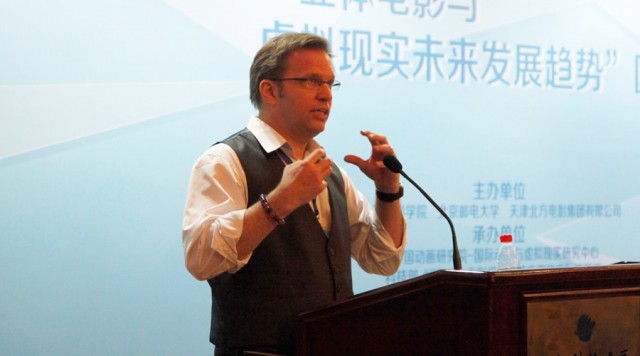
Kevin Geiger, Executive Director, International Animation & Virtual Reality Research Center, Beijing Film Academy. Image courtesy of the iAVRrc
6. Is Technology Lagging?
技术落后吗?
There is much talk of the ‘killer app’ that will spark the VR revolution. Actually, Charles Wang (Director of Movie Virtual Production Lab, BFA) suggests, we already have those applications in mind but the tech isn’t sufficiently sophisticated to realize them. Talk of lives lived in virtual reality are massively premature; we’re decades away from the internal, Matrix-like pill that stimulates our synapses and nerve endings that will be needed to create anything like ‘reality’. We still don’t use VR for more than 20 minutes at a time, largely because of the nausea. There are motion sickness-combatting solutions at hand though: tunneling, which blurs peripheral vision; teleporting, where the user picks a point and moves there instantly; and VR experienced in the third person.
有很多人认为‘killer app’会激发虚拟现实的革命。事实上,Charles Wang(北京电影学院电影虚拟化制作实验室主任)表示,其实我们脑海中已经知道如何应用虚拟现实,只是技术还不够精细,无法实现。有关虚拟现实下的生活 的探讨远不够成熟;创造‘现实’需要突触和神经末端,而刺激突触和神经末梢需要如同内部母体一样的药片来实现,我们离这一步还差几十年那么远。人们一次性 使用虚拟现实不会超过20分钟,主要原因是会产生眩晕恶心的感觉。现在已经有一些应对这种眩晕的方法:如,隧道技术,模糊周边视觉;远程跳转,用户可以选 择某一点,然后迅速移动到这一点;还有通过第三个人来体验虚拟现实。
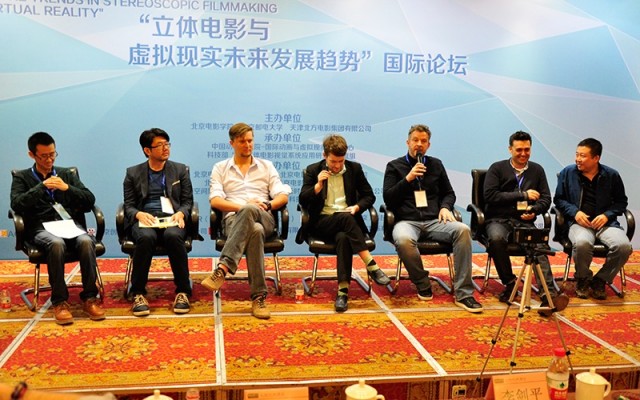
Panelists (L to R): Aaron Zhou, Animation Director & Lead Producer, Big Big Sun Creative & Development Ltd – Liu Yu Shu, Founder & Director, Animaze Studio – Jan Heinze, COO & Executive Producer, Pixomondo China – Nikk Mitchell, moderator – John Dietz, Founder & Producer, BangBang – Gavin Boyle, Director of Previsualisation, Base FX – Charles Wang, Director of Movie Virtual Production Lab, Beijing Film Academy
7. VR As A Tool In Education
将虚拟现实作为一种教育工具
Some fear technology is already leading children to disengage with the ‘real world’, while others believe immersive media may be a means to inspire and re-engage pupils. Since we have been raised on 2D media, Chuck Williams (Head of Development, Marza Animation Planet) outlined the need to develop a new grammar of 3D interactive storytelling. Would children raised interacting with virtual worlds develop an intuitive understanding of this new language, thus becoming the creators of tomorrow?
有一些人担心,技术已经导致一些孩子脱离了‘真实世界’,但是有的人则认为,沉浸式媒体可以作为激励学生,重新找回参 与度的方式。鉴于我们是伴随着2D媒体长大的,所以Chuck Williams( Marza Animation Planet的开发总监)阐述了开发3D互动讲故事新规则的需求。和虚拟世界进行互动的孩子们是否会对这种新的语言有一种直观的理解,进而成为未来的创造 者?
There is much talk of China ‘catching up’ creatively with the west. The concept of VR in education presents an interesting opportunity for China to get ahead of the game. With more smartphones in circulation than any other country, and a deluge of VR hardware being manufactured, forward thinking could see VR brought into a Chinese education system in much need of creative reform.
有很多人谈论着中国的创意发展“直追”西方。将虚拟现实应用在教育中这一概念对于中国迈向技术前段带来了很有意思的契机。中国智能手机用户比任何一个国家都多,虚拟现实硬件制造大肆泛滥,前瞻性思考告诉我们将虚拟现实应用到中国的教育体系,需要一场创意改革。
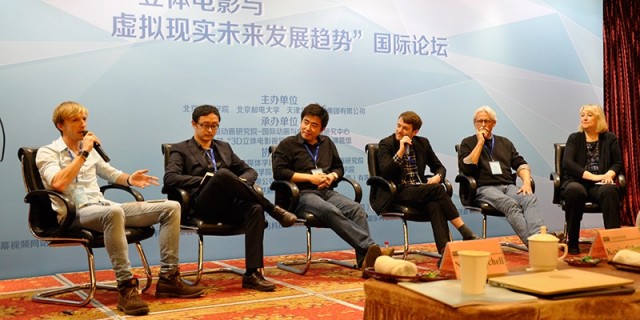
Panelists (L to R): Christopher Colman, SHP+ & China Correspondent, AWN.com – Ric Luo, Co-Founder, Ress Immersive Interactive – Yi Yan, Co-Founder, Magic Dumpling Entertainment – Nikk Mitchell, moderator – Michael Scroggins, Computer Animaton Lab Director, California Institute of the Arts – Shelley Page, Head of International Outreach, DreamWorks Animation – Andy Deck, Artist, School of Visual Arts
8. A New Storytelling Language
一种全新的讲故事语言
“Storytelling is always retrospective. If VR can make things live, then it can’t be storytelling as we now know it,” posited Woods. He cited the example of games which use cut scenes to advance the narrative. How can virtual reality tells stories if the user can move freely in a 360 space? VR challenges directors to think in new ways to tell their stories, but Chuck Williams tells us emotional engagement and the four key elements (world, character, plot, theme) remain equally as critical in VR storytelling.
“讲故事总是要不断地回顾。如果虚拟现实可以让事物栩栩如生,那现在其实我们知道了,它不是在讲故 事,”Woods如此说道。他也援引了实例,比如说,游戏中采用过场动画推动叙事。如果用户可以在360度的空间里自由移动,那虚拟现实怎么可能会讲故事 呢?虚拟现实给导演抛出了挑战,如何以新的方式讲故事,但是Chuck Williams告诉我们,在虚拟现实故事叙述中,情感投入和四个基本元素(即,环境,人物,情节,主题)仍旧同等重要。
How much will the user actually want to interact? Will users become tired moving around? Maybe there is more power in a story told in which the user is present but unable to control the outcome – the helpless observer, or the Swayze Effect (a ‘Ghost’ reference – shouting, but no-one’s hearing).
用户实际想在多大程度上参与互动?到处移动用户会不会感觉很厌烦?或许,更强大的讲故事的方法是让观众呈现在其中,但是却无法控制结局 – 无助的观察者,或者叫“斯韦兹效应”(参考电影《人鬼情未了》—大声叫喊,却没有人听得到)。
The Roundtable discussion. Image courtesy of the iAVRrc
9. Immersive Media In Visual Effects Production
视觉特效制作中的沉浸式媒体
Just like real time rendering and the rise of big game engines like Cinebox, VR is just another element to an ever-evolving toolset available to VFX creators. It’s not unusual for filmmakers to incorporate these into their process. The key, Gavin Boyle (Previs Supervisor, BaseFX) says, is getting directors comfortable with new technology.
就如同实时渲染和诸如 Cinebox这样的大型游戏引擎的崛起一样,虚拟现实对于视觉特效师来说,只是另一个不断发展的工具。电影人把它融入到他们的制作过程中并不是什么不同 寻常的事。Gavin Boyle(BaseFX视觉预览总监)表示,问题的关键在于这项新的科技如何让导演舒舒服服地使用。
So what’s next? Boyle envisions directors using a viewfinder to move through virtual environments, shooting virtual video of their desired shots. John Dietz (Producer BangBang believes the next major step is 3D Scanning over time. Dealing with game engine-like pre-built virtual worlds changes supervisor’s role to be more closely aligned with the editor and DOP, virtually moving lights and positioning cameras (thus removing the ‘painful’ parts of the current process). Overall crew size will be reduced and production will be handled by smaller, isolated teams. Jan Heinze sees the tech democratizing the creative process, making it more fluid and accessible, liberating the artist.
那么接 下来是什么呢?Boyle的预见是,导演会使用取景器在虚拟环境中移动,拍摄他们想要的场景的虚拟视频。John Dietz(BangBang的制片人)认为,下一个主要的步骤是3D扫描。在像游戏引擎一样,事先搭建好的虚拟世界里,总监的角色发生了转变,要和剪辑 师和摄影指导更加保持一致,在虚拟世界里挪动灯光,定位摄像机(这样可以移除现在流程中‘令人痛苦’的部分)。整个制作人员的规模会减少,制作也可以由规 模更小,分布在不同地方的团队完成。Jan Heinze认为这一技术让创意过程变得民主化,更为流畅,易于理解,让艺术家得以解放。
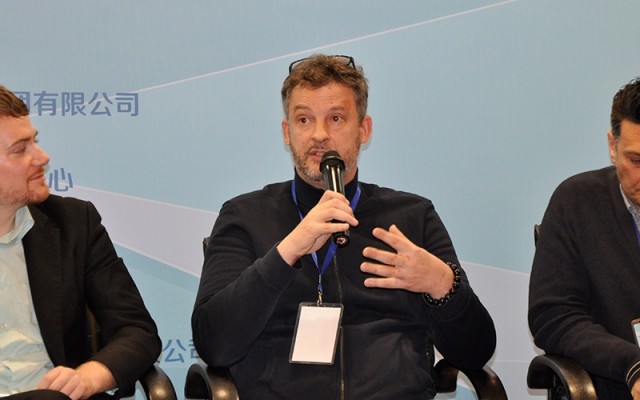
John Dietz, Founder & Producer, BangBang
10. Will VR Make Us More Social?
虚拟现实会让人们更乐于社交吗?
To what extent will our future lives be lived in virtual worlds, and what will be the nature of our interaction within them? It seems unlikely that we will use true recreations as our virtual avatars. How can meaningful interaction take place considering over 90% of human communication is non-verbal? Crucially, as Williams says, ‘a real benchmark will be finding a real human experience in VR.’ Will the virtual world become littered with AI avatars, indistinguishable from those controlled by humans? Will avatars die with their master, or will their soulless corpses continue wandering the virtual landscape just as the Facebook pages of the dead remain online? For the masses to start socializing in virtual reality, it will need to mark an improvement on current socializing options. Again, it’s a question of ‘why use VR?’
在 未来,我们的生活会在多大程度上生活在虚拟世界中,在虚拟世界中人们互动的性质又是什么样的呢?我们似乎不太会采用真实的娱乐作为虚拟化身。如果人和人之 间的沟通由90%都是非语言的,那么怎么样才能实现有意义的互动呢?正如Williams所言,关键在于,‘对于虚拟现实中人们的真实体验,要找到一种真 正的基准。’虚拟世界中是不是会堆满凌乱的人工智能化身,从而无法和人所控制的化身区分开来?这些化身是否会随着主人的离开而消亡,或者说,这些没有灵魂 的尸体还会继续游荡在虚拟世界中吗,就如同Facebook网页上那些离开人世的页面仍旧存在一样?要想让普通大众开始在虚拟世界中进行社交,那就要让他 们看到这种社交同现有的社交方式相比,有所改善和提升。这又一次说明,问题的关键在于‘为什么要使用虚拟现实?’
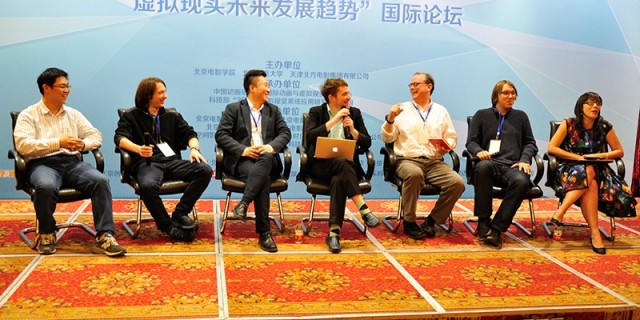
Panelists (L to R): Qiu Jiaqiu, Director, Caixin Media Company Limited – Tyler Nilsson, Co-founder & Director, Coal Car Studio – Weng Dongdong, Associate Professor, Beijing Institute of Technology – Nikk Mitchell, moderator – Flip Phillips, Professor of Psychology & Neuroscience, Skidmore College – Shane Nilsson, Co-founder & Director, Coal Car Studio – Tanja Barnes, Community Manager, Roundme, Verdom IT Projects
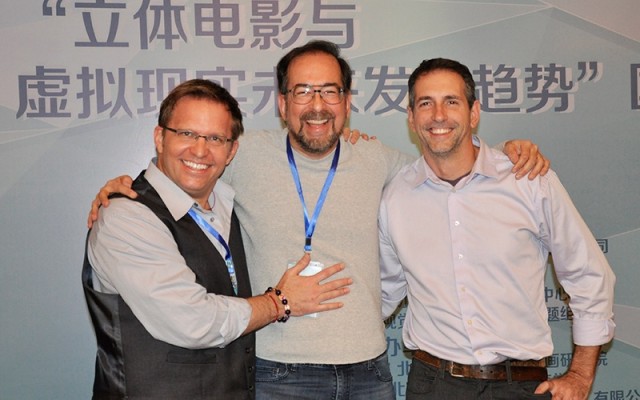
Nik Ranieri reunited with fellow Walt Disney Feature Animation CHICKEN LITTLE alumni, Kevin Geiger and Corey Smith, who worked with Nik on his first 3D CGI character.
A Few Forum Follow-ups:
论坛补充:
- Beijing Film Academy’s International Animation & Virtual Reality Research Center
- Caixin Media director Qiu Jiaqiu’s comments that virtual news could be a means of carrying out the media’s duty to convey the truth more effectively, called to mind Vrse.works and Vice’s recent 360-degree coverage of the Millions March.
- Event co-host Nik Mitchell is founder of VR-China.com
- Disney’s Playmation toys use haptic feedback to provide interactive experiences, without headsets or screens.
- Nik Ranieri was Animtion Director for World War Toons by Reload Studios.
- For a comprehensive overview, read Piper Jaffray’s Next Mega Tech Theme is Virtual Reality (English only)
- 北京电影学院国际动画与虚拟现实研究中心
- 财新网主任邱嘉秋评论说,虚拟新闻可以作为履行媒体责任的一种方式,可以更有效地传达出事实,比如说works和Vice News最近记录的360度百万人游行报道。
- 活动搭档主持Nik Mitchell是VR-China.com的创始人
- Corey Smith引进了迪士尼互动玩具Playmation。这款玩具采用了触觉反馈,不需要耳机和屏幕,就可以为用户提供互动式体验。
- Nik Ranieri在由Reload Studios执导的电影《世界大战卡通城》中担任动画导演。
- 欲了解全面信息,请参考Piper Jaffray写的Next Mega Tech Theme is Virtual Reality(只有英文版)




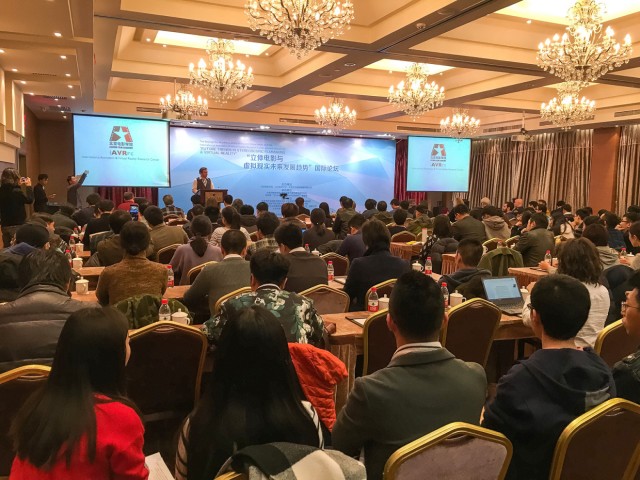
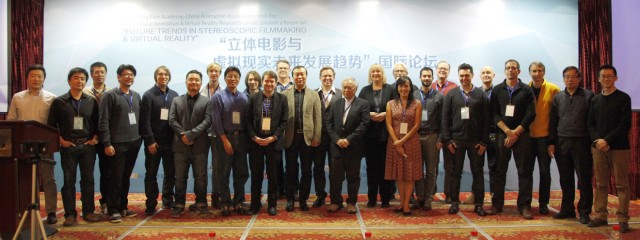
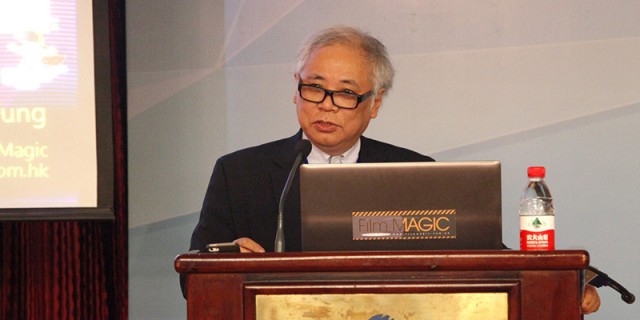
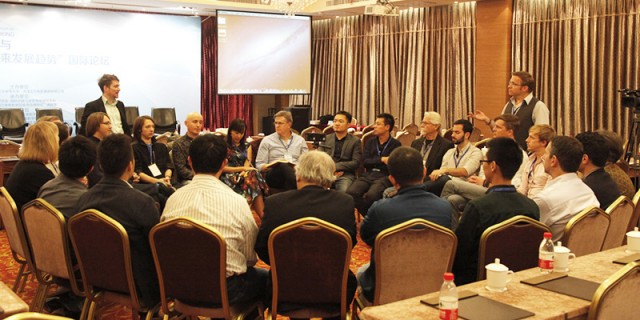
 BAM Music Library Brings Edgy, Indie Sounds to Chinese Creatives
BAM Music Library Brings Edgy, Indie Sounds to Chinese Creatives
